This is a Nikon FM2n, a 35mm SLR camera which was an update to the original Nikon FM2 produced by Nippon Kogaku K.K. in Tokyo, Japan during the years 1982 to 2001. Both versions of the Nikon FM2 had a very long production life as it remained the highest spec mechanical shutter SLR in the company’s lineup and was often used as a backup or secondary camera for professional photographers who used electronic shutter cameras like the F3, F4, and even the F5. That it could be used entirely mechanically at all speeds without any power was hugely appealing to photographers who demanded ultimate reliability. Despite being a mechanical camera, it still has the modern convenience of a Silicon Photo Diode exposure meter with a match LED in the viewfinder and a top 1/4000 shutter speed with 1/250 X-sync.
Film Type: 135 (35mm)
Lens: 50mm f/1.8 Nikkor coated 6-elements in 4-groups
Lens Mount: Nikon F Bayonet
Focus: 1.56 feet / 0.45 meters to Infinity
Viewfinder: Fixed SLR Pentaprism with Interchangeable Focus Screens, Both Shutter Speed and Aperture are Visible, 93% Field of View
Shutter: Vertically Traveling Metal Focal Plane
Speeds: B, 1 – 1/4000 seconds
Exposure Meter: (2x) Silicon Photo Diode TTL Meters with Viewfinder Match LED
Battery: (2x) 1.5v SR44/LR44 Silver Oxide/Lithium Batteries
Flash Mount: Hot shoe and M and X Flash Sync, 1/250 X-Sync
Other Features: Self-Timer, DOF Preview, Full Information Viewfinder, Optional Data Back and Motor Drive Couplings
Weight: 802 grams (w/ Nikkor 50mm f/1.4) / 548 grams (body only)
Manual: https://www.cameramanuals.org/nikon_pdf/nikon_fm2.pdf
How these ratings work |
The Nikon FM2 is quite simply, the ultimate Nikon SLR. It has all of the features you need whether you are a causal, advanced, or professional photographer. This is a mechanical camera that was in production for a very long time and has remained popular even longer than that. Although I declare it to be the ‘ultimate’ Nikon SLR, that doesn’t mean it has every possible feature. In fact, part of the reason this camera is so great is because of what it doesn’t have. This is a simple and easy to use camera that does everything you need and nothing you don’t. My favorite Nikon film SLR. | ||||||
| Images | Handling | Features | Viewfinder | Feel & Beauty | History | Age | |
| 2 | 2 | 2 | 2 | 2 | 2 | 0% | |
| Bonus | +1 for overall excellence, the complete picture, +1 for my declaration that this is the best camera I have ever shot | ||||||
| Final Score | 14.0 | ||||||
History
 In 1977, Nippon Kogaku of Japan would release a new camera called the Nikon FM. Following in the footsteps of pretty much every other Japanese camera maker, the Nikon FM was the first new Nikon SLR with a more compact body and one which used increasing amounts of weight saving materials. Prior cameras were either from the professional level Nikon F and F2 series or the full frame Nikkormat series which first debuted in the 1960s.
In 1977, Nippon Kogaku of Japan would release a new camera called the Nikon FM. Following in the footsteps of pretty much every other Japanese camera maker, the Nikon FM was the first new Nikon SLR with a more compact body and one which used increasing amounts of weight saving materials. Prior cameras were either from the professional level Nikon F and F2 series or the full frame Nikkormat series which first debuted in the 1960s.
The Nikon FM’s body was made of an aluminum-copper alloy called duralumin which was lighter, but just as rugged as the heavy brass bodies of previous models. Along with a smaller body, the Nikon FM also supported newer “Automatic Indexing” lenses first released a few months prior on the Nikkormat FT3.
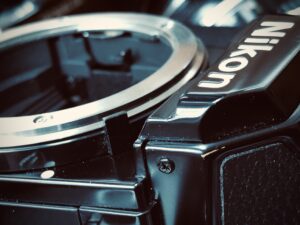
Lenses that supported “Automatic Indexing” or Ai for short, had a new ring around the lens mount which mated up to a tab on the body allowing the camera’s metering system to automatically index the aperture ring. Earlier Nikon lenses supported aperture to body communication via a different type of external coupling affectionately called “bunny ears” in which a metal post connected to the body’s metering system slid between two prongs. While this method allowed the body to detect the position of the aperture ring on the lens, it was difficult to install and required the lens to be manually indexed after each time the lens was mounted. With the new Ai lenses, no additional steps were needed to index the lens and the camera could immediately detect the f/stops of any lens mounted.
The new Nikon FM was an immediate success. With a smaller and lighter weight body, plus a match LED metering system, and support for the Nikon F bayonet, it was a very popular option as a backup camera to professional photographers who wanted to use their lenses on a smaller body, or for those who wanted to get into the Nikon F system and possibly upgrade later.
A year after its release, an electronic version of the FM called the Nikon FE made its debut with a similar body and features, but with the addition of an electronically controlled shutter and automatic exposure. Nippon Kogaku had experimented with electronic shutter control with the Nikkormat EL and Nikon EL2, but this was the first compact SLR with the feature.
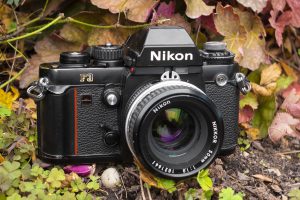
The use of an electronically timed shutter in a Nikon SLR foreshadowed the Nikon F3 from 1980 which added the feature to its professional series of SLRs. The inclusion of battery dependent electronics in a pro level camera was highly controversial as pros felt that the reliability and dependency of batteries meant that the cameras wouldn’t survive the harsh conditions that photographers were used to using their Nikon cameras in.
With the benefit of hindsight, these concerns proved to be invalid as the Nikon F3 would go on to enjoy a very long 21 year production run with many examples still functioning well more than 40 years after the camera’s introduction.
Within a year after the release of both the Nikon FM and FE, Nippon Kogaku looked for ways to improve the cameras and add new features. One of the first priorities for the company was to find a way to increase shutter speeds to improve flash sync speeds. In the era of leaf shutter rangefinders who enjoyed flash sync speeds of 1/500 seconds and higher, the relatively slow 1/125 maximum sync speeds on focal plane shutter cameras was becoming an obstacle.
In order to speed up the flash sync speed, the entire shutter mechanism had to be improved, shortening the time it took for both the first and second shutter curtains to fully open and close. The faster the curtains could physically move, the faster the maximum sync time could be. In the late 1970s, the fastest focal plane shutters were 1/2000 but all currently available models still only had a 1/125 sync speed. To address this issue, Nippon Kogaku worked closely with Copal and would set a primary objective to create a faster flash sync speed was given a high priority while a faster overall maximum shutter speed was second.
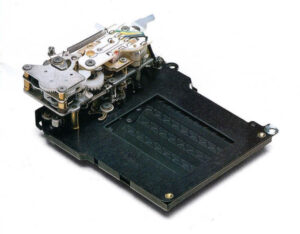
A team was put together to solve this challenge by improving two key components, first the speed at which the shutter curtains moved needed to be improved, but also the weight of the shutter curtains themselves needed to be lightened. Solving one problem but not the other would end in failure as the tight tolerances of the shutter blades themselves would ultimate fail with repeated use. A variety of light weight metals and metal alloys were tested, with the ultimate winner being Titanium, a lightweight and strong, but expensive material to manufacture. During development of the new shutter, prototypes were installed into Nikon FE bodies and controlled electronically. The new shutter would have a faster sync speed, but would be limited to the original top speed of 1/1000.
For what would eventually replace the Nikon FE and FM, the new shutter would eventually have a maximum speed of 1/4000 and a flash sync speed of 1/200. In addition to the new shutter, other new features would be support for interchangeable viewing screens, a flash ready indicator in the viewfinder, and a simplification of the power circuit so that a half press of the shutter release would automatically turn the camera on and off.
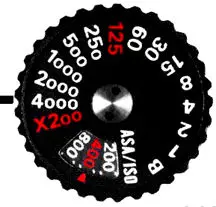
On additional feature was planned but never finished, which was the ability for automatic film loading. The plan was to put a small electronic motor in the take up spool in which after installing a new cassette, would automatically pull out the leader and ready it for the first exposure. The motor would only be used for film loading and would not advance the film nor rewind it, but complications arising from making the system work properly on a camera with manual film advance caused the idea to be scrapped.
Throughout the development of the next Nikon SLR, the plan always was to create two separate models, one each as replacements for the FE and FM. Which camera would come first was not decided early on, but in 1982 the world would get its answer with the release of the Nikon FM2, the world’s first camera with a 1/4000 shutter speed. Although I could find no explanation for why the FM2 was chosen over the FE2, my best guess would be that the new camera’s greatest benefit was its faster flash sync speed, a feature more more likely to be used by electronic-phobic professional photographers, so the model with a mechanical shutter was chosen.
When it was released, the FM2 retained the same midsize hybrid metal and composite material body as the original FM and full support of the long lived Nikon F-mount. The shutter would retain the 1/200 flash sync speed of the prototypes, but the top speed increased to 1/4000. It would feature a new interchangeable focusing screen with up to 3 options which were not backwards compatible with those from the pro F-series, a new power switch, and a flash ready LED in the viewfinder.
A new meter in the FM2 used a pair of Silicon Photo Diodes, replacing the Gallium Photo Diodes in the FM which were more expensive to make and suffered from noise due to light sensitivity behind the visible spectrum. One final change was the loss of support for non-Ai Nikkor lenses which were backwards compatible with the FM via a folding coupling pin. For photographers who wanted to use the Nikon FM2 but still had Non-Ai lenses, they would need to get the lenses modified for them to mount to the camera.
Beyond a few other very minor changes, the Nikon FM2 kept what was good about the FM and simply made it better. When it was announced, the Nikon FM2’s fast 1/4000 speed shutter was its signature feature. Ads such as the one below claimed that the camera was faster than a speeding bullet, able to capture the motion of a bullet as seen in the sample pic below.
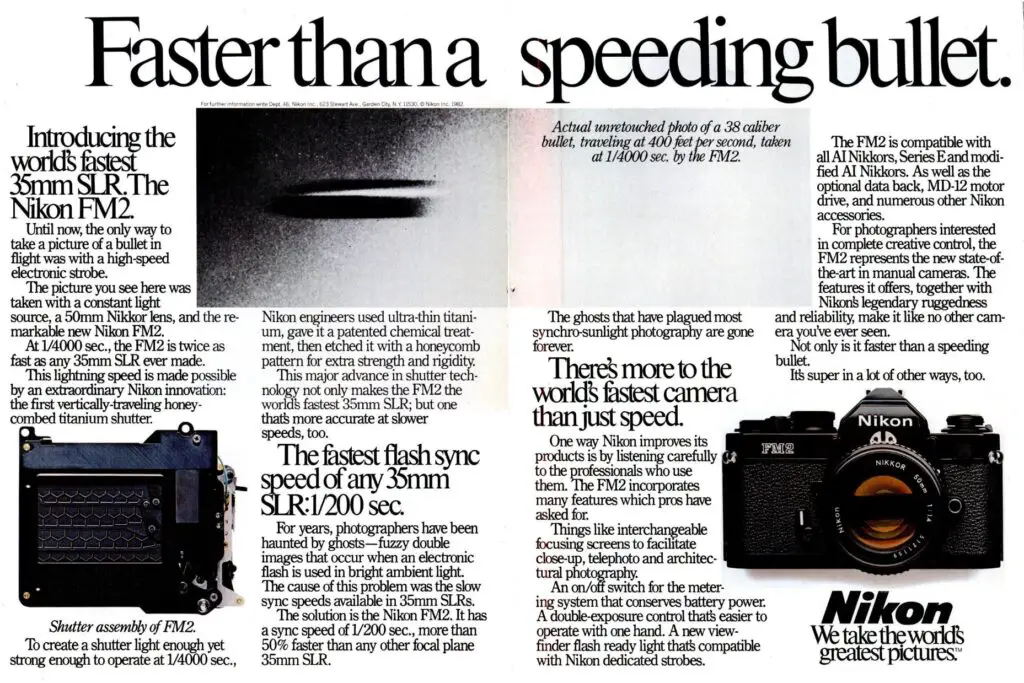
Shortly after the release of the Nikon FM2, the camera was updated with tweaks to the shutter, improving the X-sync shutter speed from 1/200 to 1/250. With this change, the number of shutter speeds went from 15 down to 14, eliminating the dedicated X200 speed and painting the 250 speed orange. In North America and Europe, the updated camera was called the FM2n, but in Japan it was called the New FM2.
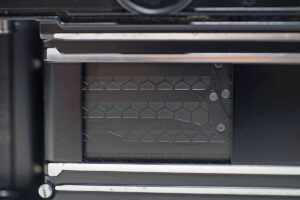
Confusingly, there were two revisions to the Nikon FM2n, the first from 1983 which upped the X-sync to 1/250, but the second happened at some point between 1989 and 1990 at which time the entire shutter was replaced with a newer one featuring aluminum instead of titanium blades. The aluminum blade shutter had the same specifications as the titanium one, but was less expensive to build. Since the actual specifications of the new shutter were identical to that of the earlier one, Nikon did not draw any attention to this change, not even bothering to give it a new name.
According to the highly detailed article about the Nikon FM2 at the Photography in Malaysia website which I believe was written around 2000, it says that there are no practical pros or cons to the new shutter. This article having been written over 2 decades before mine, I would agree that there is no evidence that the aluminum shutter is any better or worse than the titanium one, other than it loses the cool honeycomb pattern.
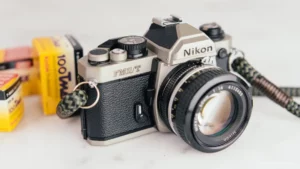
In 1994, a special edition of the FM2 was released with titanium top and bottom plates called the Nikon FM2/T. The use of titanium in its construction reduced the weight of the camera body by about 35 grams, and had a less shiny matte titanium colored finish which looked different than non-titanium chrome bodies. Strangely, the titanium version of the FM2/T camera did not have a titanium shutter, as those were discontinued a few years prior. Nikon FM2/T bodies, will have serial numbers beginning with the letter “T”.
In addition to the FM2/T special editions, a couple other limited edition versions of the camera were made over the years including “Year of the Dog”, LAPITA, and in 2000, a special Year 2000 Millennium version of which only 2000 were made. In each of these examples, no functional differences were made to the camera, with only cosmetic changes being made.
It is not entirely clear when the Nikon FM2n officially went out of production as I’ve seen some sites claim as early as 1996, but the presence of the year 2000 version clearly show that the camera limped into the 21st century. Assuming a small batch were made in 2000 and new unsold stock was probably available for a year or two after that, I tend to agree with the sites that say 2001 is the last year of production which means the FM2 family enjoyed a long 19 year life.
Today, the Nikon FM2 and its variants remain a very popular choice for film shooters today. While many collectors seek these models out, this is the rare instance where I believe a larger number of people who have FM2s use them, at least semi-regularly. When Nippon Kogaku created the successor to the original FM, they unknowingly created one of the brand’s longest lived and sought out models. Sure, it wasn’t considered a pro camera, and no, it didn’t have all of the electronic automation of later models, but it hit that right balance of mechanical reliability, exceedingly high build quality, maximum compatibility, and a simple operation with just the most important features.
If you are looking to get into film photography, or Nikon film SLRs in general, the Nikon FM2 is a terrific choice, as you could do a LOT worse with many other models out there.
My Thoughts
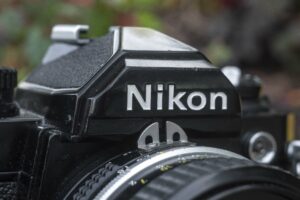
Why buy a new Nikon SLR? I’m not talking about back in the 1970s, 80s, or 90s when these cameras were actually new, when people upgraded from an older model to a newer one which had features their previous one didn’t have. I’m talking about now. If you’re someone like me who already has a shelf full of nice and perfectly working Nikon SLRs, why get another? Specifically, why the Nikon FM2?
That is a question I’ve asked myself a number of times, and so far, one I can’t really answer. Now, before I go too far down some kind of self-reflecting enlightenment journey, I should say that prior to picking up this Nikon FM2, I had SLRs both by Nikon and their competitors that could do everything this camera could. I’ve previously reviewed the Nikon F, F2, F3, FA, EL2, and a couple Nikkormats, all of which are great cameras.
But if there was one thing that each of those cameras don’t have is the “perfect” combination of features. Each of them has a long list of features and many strengths, but there’s always something another Nikon does better. The Nikon F2 improved upon the ergonomics of the F, the F3 added auto exposure, the EL2 had auto exposure, but was a large and heavy camera, and the FA had a smaller, more compact body, with AE and a whole bunch of features. but was an electronic ticking time bomb that could die at a moment’s notice. Certainly, all of these cameras were good, but were any of them “perfect”.
Enter the Nikon FM2. I know a large number of people who love this camera, and rightfully so, it was the backup to many pro photographers, sometimes stepping up into primetime duty like when Steve McCurry captured his iconic “Afghan Girl” photo in 1984. I know many people, collectors, and photographers who also love this camera, as I suspect a good number of people reading this review do too.

So, why even bother with a review? Why take the risk of missing something about the FM2 that those people already understood? Why repeat what has likely already been said a jillion times, both online and IRL? For me, having shot so many different cameras, is it even possible for me to give a fair assessment of a camera when so many of them start to blur in my mind moments after finishing up a review and starting on another? I don’t have the answers to those questions, so I guess I’ll just go with, “why not”?
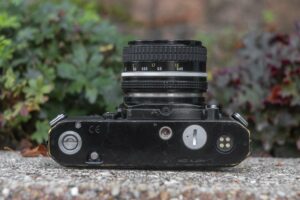
The FM2 is wonderfully constructed. This is a camera that is neither too big, and neither too small, it is neither too heavy, nor neither too light. It has a perfect balance of classic cold metal and space age weight saving materials. The camera’s various knobs, levers, and buttons all have excellent fit and finish and do not wobble or appear as though any cost saving was applied to their design in the name of saving a buck. This is even more impressive, considering that all FM2s are between 23 and 41 years old, depending on which one you have. Nikon was never known for taking too many changes, both in function and form, preferring to tweak and evolve successful formulas to keep up with the times, while not alienating its loyal customer base. The FM2 takes no risks from previous models, and whether this is the 1000th time you’ve picked up this camera, or the first, there will be an immediate feeling of familiarity.

Like most SLRs produced from the late 1950s through, basically today, the control layout is straightforward. Up top, the rewind knob is on the left, prism and hot shoe in the center, combined film and shutter speed dial, cable threaded shutter release, exposure counter, and film advance lever. The sides have front angled strap lugs which help balance the camera while hanging from your next, and on the bottom is a 1/4″ tripod socket, round battery door, and both mechanical and electrical couplings for the optional motor drive.
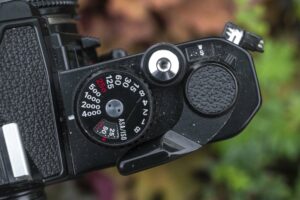
The Nikon FM2 was first released in 1982, but was quickly updated in 1983 to an “N” model. Officially, the camera was still marketed as the FM2, but for collectors the later version is referred to as the FM2n. Since a majority of the FM2s ever made were the “N” model, how you can tell them apart is the inclusion of the letter “N” in front of the serial number on the back of the camera and also by looking at the selection of shutter speeds. The original model had a flash sync speed of 1/200 which was indicated by an extra X200 speed after the 4000 setting and the 125 speed indicated in orange. The “N” model has no such X200 speed, but instead the 250 speed is indicated in orange.
If you’re new to Nikon SLRs, a feature they adopted when they made the switch to unlocking the film door with the rewind knob, is that there is a little lock for the rewind knob itself. In order to lift up on the knob to open the door, you must first push a black lever below the rewind knob towards the back of the camera while pulling up on the knob. Once the knob is in the up position, a firm upward tug will unlock the door. This is much easier to do in person than it probably seems, but might throw off the first time FM2 user if you can’t figure out how to open the film door.
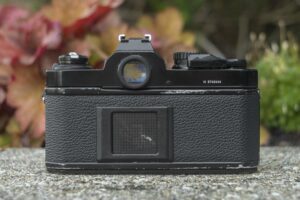
Around back, there is a film box end reminder window and the eyepiece is externally threaded for viewfinder accessories. The camera’s serial number is on the back and begins with an “N” if it is the updated FM2n model. Since the original version of the camera is far less common, seeing a serial number without the “N” is unusual.
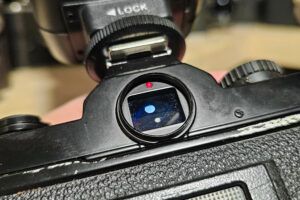
An interesting feature that I wasn’t even aware of until I was researching this review is a small red LED immediately above the rear eyepiece, inside of the circular filter ring. This LED is a flash ready indicator, a new feature added to the FM2 which wasn’t present on the FM. This light requires the use of specific Nikon Speedlites from the era in which this camera was made. The FM2 manual has a full list and most models within the range of the SB-10 through 22 should work, although there are some exceptions. Its purpose is to notify you when the flash has sufficient charge to expose the image for the shutter speed you’ve selected. The LED will light up continuously at speeds 1 – 1/250 plus Bulb, and will blink at speeds 1/500 – 1/4000.
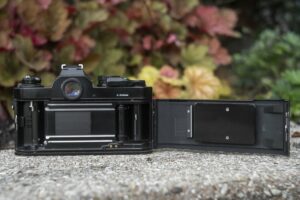
Inside the film compartment, the FM2 sticks with its classic layout, eschewing things like DX film detection or a quick load film mechanism. Although both of these features were available by the time a bulk of these cameras were made, Nikon instead preferred mechanical simplicity to keep the electronics (and failures) down. One thing to beware of is that the FM2 came with foam light seals which on most examples should be well on their way to failing. It would be a good idea to replace the hinge and door channel seals before shooting this camera, not only to protect your film from light leaks, but also to prevent pieces of the foam from breaking off and getting stuck in the shutter. The Nikon FM2’s shutter is one aspect of the camera that received multiple updates throughout its life. The original model had titanium blades with a honeycomb pattern. This version has titanium blades without the honeycomb pattern, and the last versions of the camera came with aluminum blades.
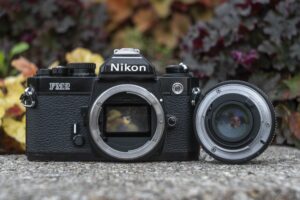
With the release of both the Nikon FM2 and FE2, the company officially ended support for non-Ai lenses which lack the Ai coupling ring. On the FM and FE, the Ai coupling pin could be folded out of the way to support these lenses, but not on the FM2 or FE2. Attempting to mount one of these lenses almost certainly will cause it to get stuck, possibly damaging the camera. This means that although there were a huge number of first and third party lenses that will work on the FM2, not all will, so you must be careful.
To the left of the lens mount is the mechanical self-timer lever, and a depth of field preview button. On the right is the lens release button for removing lenses. Pressing this button while rotating the lens clockwise removes it and rotating it counterclockwise will attach it.
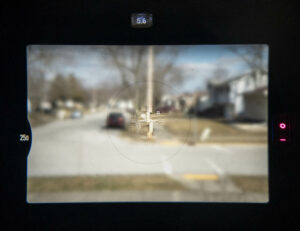
The viewfinder is one of the FM2’s best features. Most FM2s will be found with a type K2 focusing screen which has a split image with microprism collar focus aide in the center, surrounded by a laser etched Fresnel pattern which maximizes brightness all the way to the corners. A 12mm circle in the center of the screen indicates the center weighted area in which 60% of the camera’s meter measures light. The viewfinder displays both the selected f/stop using a judas window at the top of the viewfinder and a rotating disc on the left side which is coupled to the shutter speed dial. On the left are three red LED, one each with a plus, circle, and negative symbol to indicate over, correct, and under exposure. The metering system on the FM2 does not have a dedicated power switch, instead it is activated by pulling back on the film advance lever to the 15 degree standoff position and half pressing the shutter release. Once the meter is activated, it will remain on for about 30 seconds after which time it turns back off.
One of the greatest things about SLR viewfinders of this era is that by then, camera makers had learned the art of maximizing brightness through the focus screens. The days of dim viewfinders with heavy vignetting and visible Fresnel lines were over. Yet, in the decades after the FM2, cameras started to come standard with kit zoom lenses with darker f/3.5 and smaller diaphragms. Plus, in the auto focus era, LCD overlays that could show detected focus position became common too, and while those features certainly have their benefits, the LCD overlay further darkens the image. Comparing the viewfinder screen of the FM2 with a normal f/1.8 lens to something like a Nikon F100 with a zoom lens and LCD overlay, and the FM2 will be noticeably brighter. For people who value brightness over anything else, the era of the FM2 was about as good as it would ever get.
Most people who read my reviews are familiar with Nikon SLRs. Even if you have never used an FM2 before, the basic formula doesn’t change too much, so what is it about this camera that makes it more or less appealing than other Nikon SLRs? Let’s see what happens when I load in some film and take it out shooting!
My Results
I’ve had this Nikon FM2 in my collection for about 4 years and for the longest time didn’t think I’d ever review it as it’s so similar to other Nikon SLRs I’ve written about, plus there is so much info out there about them anyway. In that time however, I found myself coming back to it a number of times, first in a trip to the East Coast in 2021 to visit some friends, and then on multiple occasions as a carry around camera when I just wanted a fun mechanical camera with no compromises. I think I’ve shot 6 or so rolls of film in this camera and as the virtual pile of scanned images started to accumulate, I thought I should probably write something about it. The gallery below is taken from two of those rolls. The color film is expired Kodak Gold 200 with a Nikkor 50mm f/1.4 lens as seen in the mirror selfie, and the black and white images are on Kodak Panatomic X 32 using a Nikkor 20mm f/4 lens which I took with me to Baltimore, MD and Gettysburg, PA.
Between the two lenses I used while testing the FM2, I found myself preferring the 20mm f/4 lens as it allowed me to open up my shooting to include much more in the picture than a 50mm lens would have typically allowed. While I could have used any number of Nikkor lenses I have available to me, I quite enjoyed the combination of the FM2 with this lens as for such a wide angle lens, it has a very small body. In fact, the 20mm was both shorter and slightly lighter than the 50mm f/1.4, likely due to having less glass inside.
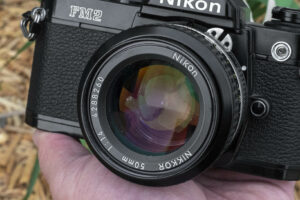
The 20mm f/4 is a rather slow lens, so its relatively small maximum aperture would have likely caused issues with viewfinder brightness on a lesser SLR, but the very bright screen of the FM2 helped to counteract that, making it very usable in all but the worst lighting situations. In addition to giving the final image an expansive, almost panoramic look to them, the lens adds a noticeable amount of vignetting which on the black and white Panatomic X, added a vintage flair. In certain circumstances, vignetting and softness in the corners is seen as a bad thing, in others, it can add to the images and in my opinion, this is the latter.
I don’t have a lot to say about the 7-element 50mm f/1.4 Nikkor as its predictably one of the most popular Nikkor lens formulas, one of which has seen very little change since the original designs from the original Nikon F from 1959. I can’t think of a more perfect kit lens for a camera like the Nikon FM2 than this f/1.4 legend, but therein lies its one and only weakness, that shooting it is kind of boring.
This leads me to an interesting characteristic about the Nikon FM2. This is a camera that is almost perfect in everything it does. It has excellent ergonomics, an excellent full information viewfinder, a wide range of shutter speeds from 1 to 1/4000 plus bulb, a modern and fast SBC exposure meter with the convenience of a match LED display, and it supports the Nikon F mount which includes many of the best lenses ever made. Sure, it doesn’t have auto exposure or many electronic features, but for that sacrifice, it has ultimate dependability and battery free operation.
For me, using the Nikon FM2 is the ultimate Nikon SLR. I said it earlier, but I’ll repeat it here. Yes, there are many other Nikon SLRs that have more features, faster shutters, more advanced CPU controlled metering systems, but for each one of those cameras that have something the FM2 doesn’t, I can count something that is not ideal about those same models.
Yes, I know about the Nikon FM3: I really feel like this is a good place to acknowledge the Nikon FM3 (I’m looking at you Hong) which arguably improves upon the FM2 while not adding any cons. Each time I look at an FM3 and compare the prices they go for compared to an FM2, I can’t justify paying triple, or even more, and getting only a marginally better camera. For me, the Nikon FM2 is a better option for most people when you also factor in cost of ownership.
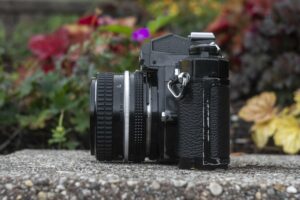
Shooting with the Nikon FM2 is so intuitive that it almost completely removes the camera from the photo making equation. Certainly, the camera plays a role, but what I mean is that with the camera to your eye, you only need to concentrate on the act of making the photo. How is the lighting, what is in the frame, will this photo tell the story I want it to, do I have the right lens for what I want to do? At no point will you have to ponder, will the titanium shutter blades expose the image correctly, or how easy will it be when I have to rewind the film at the end of the roll. Everything about the camera’s controls and operation are as they should be with absolutely no cons, and for me, that describes my ideal camera.
There are a lot of great cameras, many made by Nikon, but quite simply, the Nikon FM2 has the perfect balance of all pros with no cons. I don’t have a single complaint, nitpick, or even a subtle thought of “gee wouldn’t it be great if this camera could…”. Quite simply, the Nikon FM2 is the best camera I’ve ever shot. Fight me.
Related Posts You Might Enjoy
External Links
http://camera-wiki.org/wiki/Nikon_FM2
https://en.wikipedia.org/wiki/Nikon_FM2
https://www.mir.com.my/rb/photography/hardwares/classics/nikonfmseries/fm2/index.htm
https://photothinking.com/2019-07-26-nikon-fm2n-small-and-tough/
https://johnnymartyr.wordpress.com/2014/07/15/my-ode-to-the-humble-nikon-fm2n/
https://www.35mmc.com/28/12/2022/nikon-fm2-camera-review/
https://casualphotophile.com/2019/01/23/nikon-fm2t-film-camera-review/
https://www.5050travelog.com/camera-and-lens-reviews/nikon-fm2n-review

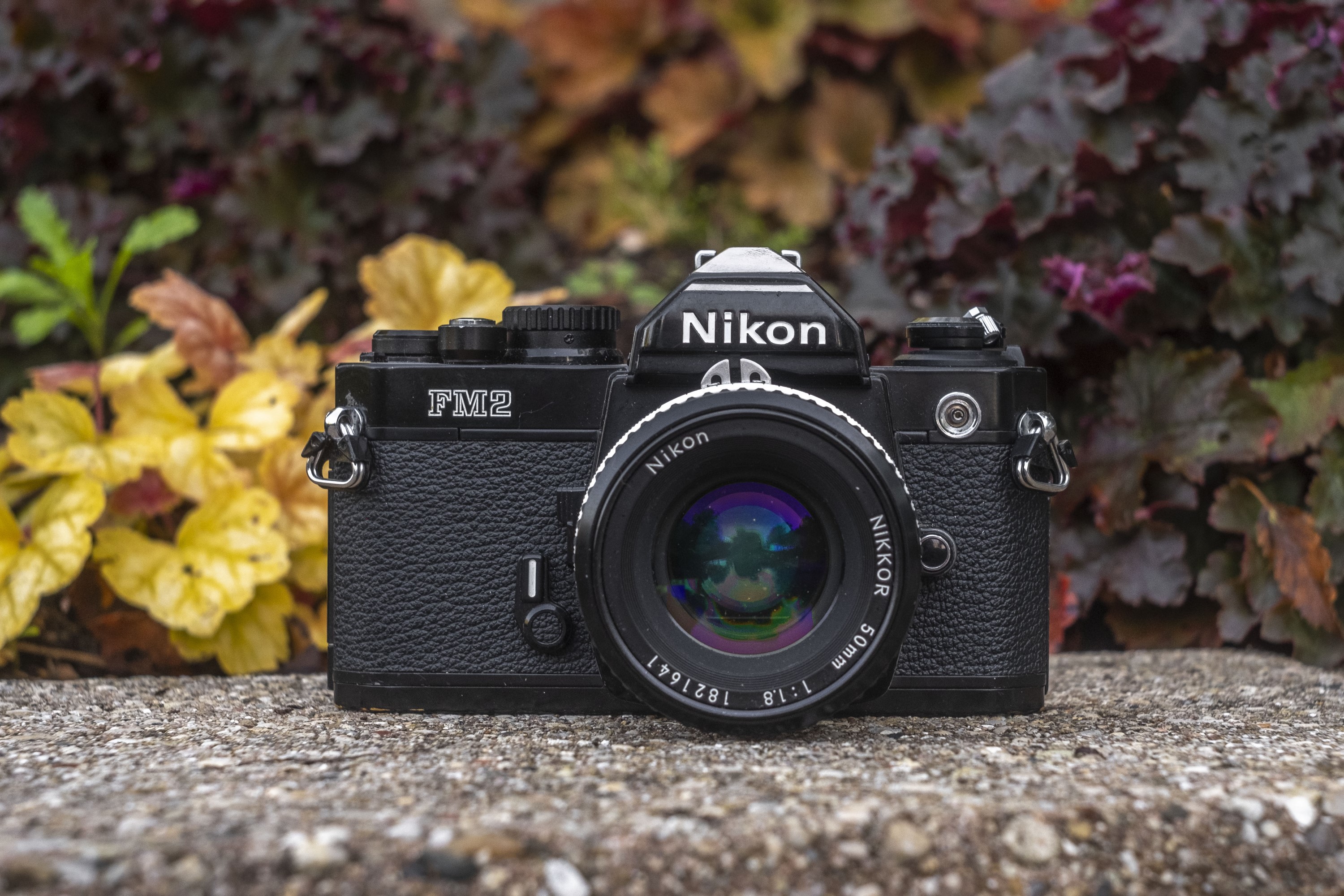
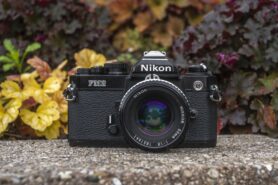
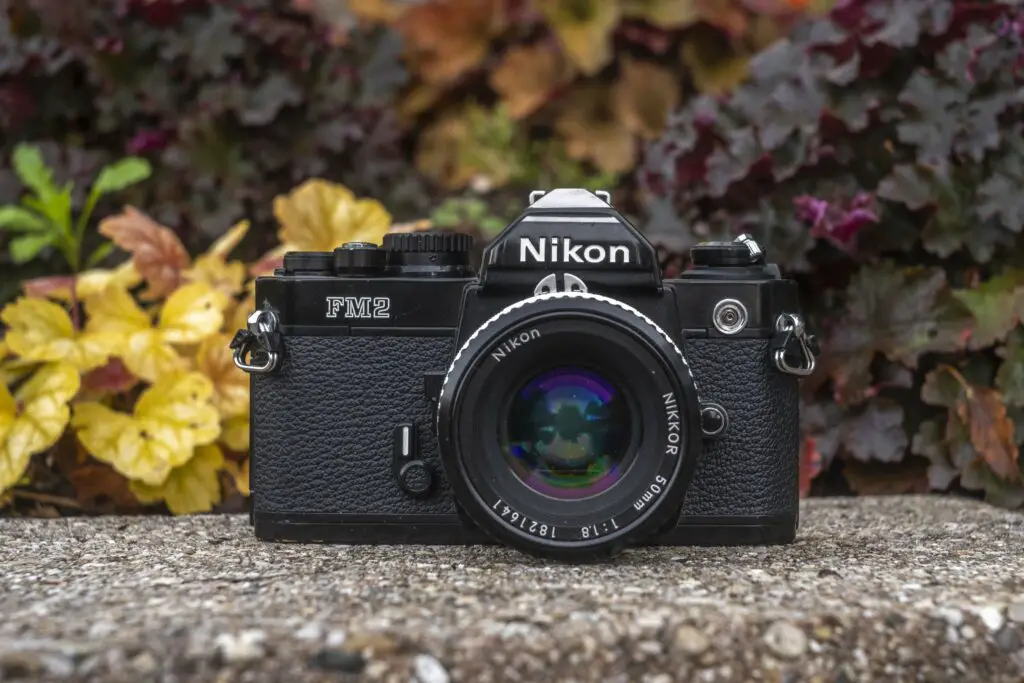
























This old man with large hands will stick with the F and F2; they’ve served me well both as moneymakers and pleasure-shooters for close to 60 years. And that f5.6 boogaloo for non-Ai lenses becomes second nature after a few rapid lens changes – I still do it automatically when shooting my Nikkormat FT3.
Great review, as always. The only part I found problematic was the statement about the FM introducing a change to the lens mount. I believe the Nikkormat FT3, Nikon EL2 and possibly the F2AS metering head had AI support and were released before the FM.
You’re right Howard, the FT3 came before the FM, and I actually knew that, I’m just making more mistakes as my brain fills up with so much history after all the reviews I’ve written! I have corrected that part of the review. 🙂
Hi Mike:
I was the author of the Wikipedia articles on the Nikon FM/FE/FM2/FE2/FA/EM/FG almost 20 years ago, and the history of the focal-plane shutter 15 years ago (I haven’t checked to see if they’ve been edited beyond recognition), and I have some technical comments.
Nikon’s history webpages says that the Nikon FM2N was released in 1984, not 1983. Modern Photography’s new product announcement for the FM2N was in their April 1984 issue, which with magazine production lead time would indicate March 1984.
I believe you are incorrect in saying the Nikon FM body was cast in an aluminum-copper duralumin alloy. An ad for the Nikon FE2 in Modern Photography’s August 1983 issue says it had a “copper silumin aluminum body,” which makes me think that Nikon compact F-series bodies used a 4000-series aluminum-silicon-copper alloy, not a 2000-series duralumin.
The FE2 was released after the FM2 for reasons unrelated to the superspeed shutter. The FE2 was supposed to include an Automatic Multi-Pattern meter, but AMP was not ready for production in time – that is, there would have been no Nikon FA if the research and development had been finished on schedule. This tidbit is in one of Nikon’s history webpages, Camera Chronicle #14. AMP used a 4-bit microchip computer, with a then blazing 524 kilohertz central processing unit (CPU) and whopping 8 kilobytes of memory. (For comparison: the very popular Commodore 64 [1982] personal computer had an 8-bit, 1 MHz CPU and 64 KB of memory for $595 and the original Apple Macintosh [1984] had a 32-bit, 8 MHz CPU and 128 KB of memory for $2495.) There was only time to install the faster eight-blade 1/250 sec. X-sync shutter.
My first, and favorite SLR, is the Nikon FE2 – I want a little automation help sometimes. I’ve also acquired Nikon FG, FM2N and FA bodies over the years.
By the way, the Modern Photography “MODERN Tests” for the Nikon FM, FE, FM2, FE2 and FA are in their October 1977, August 1978, September 1982, October 1983 and March 1984 issues, respectively.
Hope this is helpful
paul1513
Paul, thanks for the additional detailed information! I wish I would have contacted you before pushing this article out! I got a lot of the technical data for the FM2 and FM2n, including the FM2n’s 1983 date from the Photography in Malaysia website, which is generally an excellent resource for Nikon history and information. They repeatedly refer to the 1983 date as when the camera was made. I do see where the Nikon History website says 1984 for the FM2n and as you point out, references to it began to appear in April 1984 suggesting a 1984 date. While I am usually inclined to go with the date mentioned on an official website, all of that Nikon History stuff is not from Nikon itself, rather a republished article from the Nikkor Camera Club. In my time researching camera history, I’ve learned there is often a disparity between when a model was finished, or announced, and when it actually became available. In my opinion, both 1983 and 1984 are valid, depending on whether you value “announced date” or “available to buy date”. I went with the earlier. In reality, its probably not a big deal.
As for the rest of your information, what you have makes sense, and I will update my article accordingly. Finally, I do not have the full FM2 test from the September 1982 Modern Photography. 1982 is one of those years I do not have a complete 12 volumes for. By any chance, would you have a scan of that test as I’d like to read it!
Thanks again for the awesome response and the support for the site. I have a review of the Nikon 28Ti coming soon, so hopefully I’ll do a better job of getting the facts right on that one! 🙂
Hi Mike:
Yes, I have a scan PDF of the Nikon FM2 MODERN Test you can have. I have scans of 90% of 1975-1986 MODERN Tests, and over half of 1965-1974 Tests. It is my goal is to have all tests from the Topcon Super D (January 1964) to the Minolta Maxxum 7000 (August 1985). This is my favorite era of photographic technology – the perfection and miniaturization of mechanical and optical components, plus the integration of electronic controls, without changing a camera into a handheld computer. (I’m sure the Nikon Z8 takes great pictures, but it’s all electronics, no mechanics, and only an eyepiece for optics.)
paul1513
I think the best description of these Nikons is “uncompromising” in terms of quality, given the price. I always remember my repair man commenting on the problems of adjusting the mirror on another make of so called professional SLR. Apparently you had to bend some soft metal. With Nikons, he said they use a cam which is simple and precise. They are great cameras and I suspect that the majority are still around and working well today.
You are spot on Nick. There are many people (myself included) who heap praise on other SLR systems by Olympus, Pentax, and other companies. When those cameras are in good working order, they might be just as easy to use and produce just as nice of results as a Nikon, however one thing that sometimes is overlooked is the attention to quality that Nikon put into their cameras. There is a reason why so many Nikon F cameras were used to shoot multiple wars, have been taken on assignment to deserts and the arctic, have gone to space, and that is because their quality is uncompromising. I like the Olympus OM-1 and Pentax MX very much, I have a couple in my collection and I enjoy using them. But if I was a photojournalist in the mid 1970s on assignment to Vietnam or Africa and my livelihood depended on me getting “the shot” every single time, I would not be using those cameras. I’d have a Nikon with me.
Got a pre Ai 50mm f/1.4 that would be cheaper to just sell. Prefer a mechanical body and have owned the FM2n in the padt. Might be my favorite film camera (along with OM2 and M3). Likely going to give the F a shot. Then discovered the Photomic… what a rabbit hole.